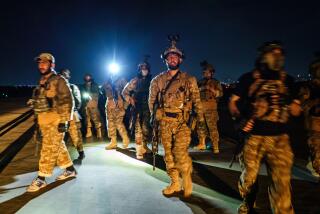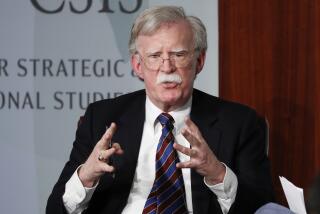Officials Reveal Bin Laden Plan
KABUL, Afghanistan — The assassination of an Afghan rebel leader 48 hours before the Sept. 11 terrorist attacks was part of a strategic plan by Osama bin Laden to expand his influence into Central Asia, according to American and Afghan government sources.
Analysts initially believed that the killing of Ahmed Shah Masoud, head of Afghanistan’s Northern Alliance, was part of Bin Laden’s preparations for Sept. 11--a move to deprive the U.S. of a potential ally on the ground when it retaliated for the suicide hijackings.
Government officials now say Masoud’s assassination was part of a more ambitious design: to establish a caliphate, or religious state, encompassing Afghanistan and parts of Tajikistan, Uzbekistan, Chechnya and the predominantly Muslim Xinjiang region of northwestern China.
“Their plan was to capture [northern] Afghanistan in one week after the assassination and--maybe two to three weeks later--capture Tajikistan and Uzbekistan,” said Mohammad Arif, chairman of the National Security Directorate in the interim Afghan government.
As Masoud’s chief of intelligence, Arif ran spy networks inside the Taliban and received reports from interrogations of Taliban and other Islamic militants captured by the Northern Alliance.
U.S. officials confirmed what they called “Bin Laden’s grand plan” to expand militarily and politically into Central Asia. American policy advisors were extremely unsettled by the plan well before Sept. 11, officials said.
“It was of great concern, absolutely,” said a senior Bush administration official. “That is one reason we wanted to get rid of him. He wanted to knock off other governments. They were training terrorists, creating front organizations.”
Though U.S. officials were less certain than Arif that Bin Laden’s Al Qaeda and the Taliban had a timetable for advancing into Central Asia, they regarded the Masoud assassination as a key step toward that goal.
“They wanted to take over the whole country ... [and then] they wanted to expand the caliphate,” said the senior U.S. official, who noted that Masoud and his resistance force were the last obstacle to Taliban and Al Qaeda control of Afghanistan.
Afghanistan’s foreign minister, Abdullah, said in an interview, “Osama believed that by getting rid of Commander Masoud, the resistance would be over.”
The former Masoud advisor conceded that Bin Laden’s judgment was sound. “It was only Masoud’s own qualities which kept the resistance alive.”
The two Al Qaeda assassins, armed with letters of introduction and booby-trapped television cameras, spent nearly a month inside Masoud’s compound and entourage, awaiting an interview promised by the rebel leader. On Sept.9, the men--Tunisians trained in an Al Qaeda camp--were ushered into a room with Masoud. A few moments later, a bomb blast riddled Masoud’s body with shrapnel.
At the same time, the Taliban’s so-called final offensive against the Northern Alliance pressed hard on three fronts. One rebel general had reported that his troops were on the verge of collapse. But the lines held.
Bin Laden expected Masoud’s killing to demoralize the resistance. But rebel fighters did not learn of their leader’s death for several days--until after Al Qaeda hijackers had flown jetliners into the World Trade Center and the Pentagon.
When massive U.S. reprisals began, the Afghan resistance was still intact and Taliban troops had retreated to defensive positions.
“The group around Osama ... thought up different scenarios. They imagined a Bill Clinton-type response,” said a Kabul intelligence official, referring to a 1998 cruise missile strike in Afghanistan that President Clinton ordered after the bombings of two U.S. Embassies in East Africa.
“They could never imagine the response that took place” after Sept. 11, the official said.
By 2000, Western intelligence had begun getting increased reports that Bin Laden was talking openly about creating an Islamic caliphate. The reports coincided with an increase in Bin Laden’s influence over his Taliban hosts.
Bin Laden lavished praise on the Taliban leader, Mullah Mohammed Omar. He declared the barely literate mullah “the new caliph” and pledged Al Qaeda’s loyalty to the “emir-ul-momineen,” or “commander of the faithful.” He urged all Muslims to “support his jihad against the enemies of Islam.”
In the spring of 2001--when the plots to assassinate Masoud and launch the Sept. 11 hijackings were underway--Al Qaeda influence within the Taliban advanced further. Bin Laden and some of his associates were invited into the Taliban decision-making council.
Al Qaeda was integrated into the Taliban military structure, according to European intelligence officials. Juma Namangani, the reclusive chief of the Islamic Movement of Uzbekistan, was given a command position with the northern military units opposing Masoud’s forces.
A Western diplomat who monitors the Taliban from neighboring Pakistan said intelligence reports at the end of 2000 indicated that Taliban leaders were discussing how to exploit an anticipated victory over Masoud and his forces. Indications were, the diplomat said, that Omar and the Taliban wanted to project their power into Central Asia “to maintain the purity of the jihad.”
The Taliban decision-making corps dwindled with the death from cancer of Omar’s prime minister, Mullah Mohammed Rabbani, a year ago. The diplomat said Bin Laden filled the vacuum.
A former Clinton administration official said some Al Qaeda figures held “this global vision of spreading an Islamic state all through Islamic lands and that [Afghanistan] was going to be sort of the base for that.” The official said he never considered the goal realistic.
Afghan military and intelligence officials said Taliban and Al Qaeda-backed fighters planned to infiltrate rapidly across the northern borders once Masoud was killed and his troops dispersed. The Afghan and Arab militants were to join forces in Tajikistan and Uzbekistan with local groups of fundamentalist guerrillas.
In Afghanistan, Bin Laden had funded and supervised the training of thousands of Uzbeks, Tajiks and other tribal fighters, specifically for purposes of military expansion, said a second Bush administration official.
Besides training terrorists in Afghan camps, Bin Laden was grooming a highly trained and disciplined fighting force for the Masoud front--a sort of Arab foreign legion called Brigade 055. Estimates of its size range from 1,000 to 2,500. The fighters were recruited from around the world and had pledged to fight to the death.
“It was the only major military organization [Al Qaeda] had in Afghanistan,” said the Kabul intelligence officer, who asked not to be identified. “The others were small units.”
Assisting Brigade 055 was a battle-hardened force of 700 to 1,000 Central Asian fighters headed by Namangani, the Islamic leader from Uzbekistan. Namangani was considered a major terrorist threat by the Clinton and Bush administrations after he organized cells in Kyrgyzstan, Uzbekistan and Tajikistan, officials said. He was reported killed in a U.S. bombing raid in November.
Such non-Afghan military units were increasingly important to the Taliban, officials said.
In interviews, Northern Alliance commanders said 2,500 to 3,000 foreign troops were facing them at the front last summer. The number grew to more than 5,000 around the time Masoud was killed. That likely explains the large number of foreign Taliban and Al Qaeda fighters who were taken prisoner in northern Afghanistan after the U.S. military campaign began, the Afghan officials said.
Arif said foreign fighters were poised to surround Masoud’s stronghold in the Panjshir Valley and to expand into Tajikistan to disrupt Masoud supply lines and try to capture a rebel air base.
Beyond the growing numbers of Arab recruits swelling the Taliban’s military ranks, small communities of foreigners began to sprout around Afghanistan. Part of Al Qaeda’s strategic plan was to establish Arab enclaves throughout regions under Taliban control--what Afghan government officials now disparage as “the Arabization of Afghanistan.”
“They wanted to establish Arab colonies all over Afghanistan,” said the Kabul intelligence officer. “They were working to create an armed force in Afghanistan dominated by Arabs. They had succeeded to a large extent. Afghanistan was a colony in the hands of terrorists.”
*
Contributing to this report were Times staff writers Sebastian Rotella in Paris; Rone Tempest in Islamabad, Pakistan; and Bob Drogin, Doyle McManus and Robin Wright in Washington; and researcher Nona Yates in Los Angeles.
More to Read
Sign up for Essential California
The most important California stories and recommendations in your inbox every morning.
You may occasionally receive promotional content from the Los Angeles Times.










